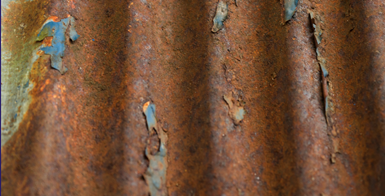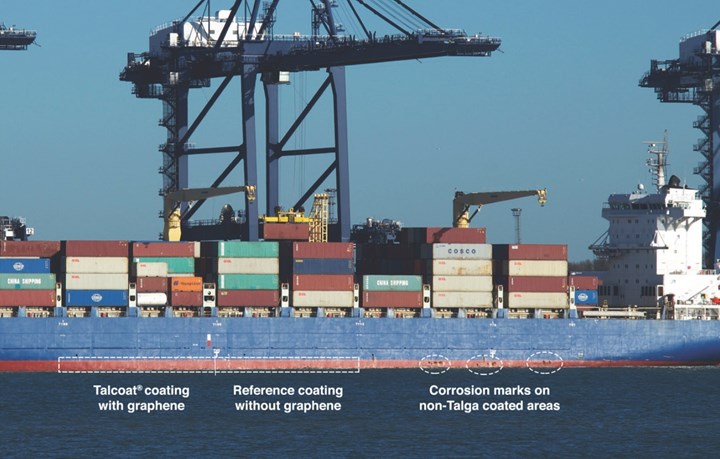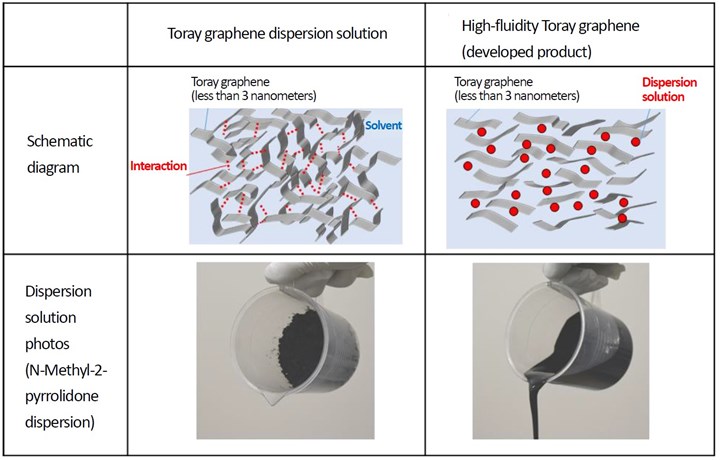
Use of graphene nanoplatelets to significantly boost performance is a relatively new but rapidly growing application area in the paint and coatings industry.
Photo | Surface Protective Solutions LLC
While their use in metal-protective products is fairly new — having been commercialized only within the last few years — graphene nanoplatelets (GNP) are proving to have an outsize impact on the performance of primers, coatings, paints, waxes, and even lubricants. Despite typical letdown ratios varying from fractions of a percent to a few percent, properly incorporated GNP becomes a multifunctional additive that can greatly extend coating life and durability; increase chemical, corrosion, oxidation, and abrasion resistance; and even help surfaces readily shed water and dirt. Additionally, GNP often acts like a synergist, helping other additives work more effectively at lower concentrations without sacrificing properties. Graphene nanoplatelets are already commercially available in metal-protective products ranging from car-detailing sealers, sprays, and waxes to primers and coatings used by automakers, building contractors, and even consumers. Many more applications (such as marine antifouling/anticorrosion primers and paints) are said to be in the final stages of testing and are expected to be commercialized within the next few years.
Remarkable but Not Easy
Single-layer graphene was first isolated in 2004 by researchers at the University of Manchester (Manchester, U.K.), who were awarded the 2010 Nobel Prize in Physics for their discovery. Graphene nanoplatelets — a multilayer form of graphene available from various suppliers in a range of particle thicknesses and average particle diameters — are a nano-scale, 2D form of carbon in planar/sheet form. Like other nanoparticles, GNP’s ability to modify and improve the performance of macro-scale products (like polymer films, plastic/composite parts, coatings, and even concrete) is completely out of proportion to their diminutive size. For example, the flat, broad, but thin geometry of GNP additives make them ideal to provide effective surface coverage in coatings without increasing coating thickness. Quite the contrary, often their effectiveness at boosting coating performance means fewer coats are needed or thinner coats can be applied. GNP materials also have a very high surface area (2,600 m2/g). If properly dispersed, they can substantially improve a coating’s barrier properties to chemicals or gases, which helps improve corrosion and oxidation protection. Additionally, from a tribological standpoint, they have very-low surface shear, helping improve abrasion resistance and slip coefficient, which helps impart better scratch resistance and the ability to repel dirt, water, microbes, algae and more to a coating. With properties like these, it’s easy to see why, even in small amounts, GNP additives can be so effective at improving the properties of a host of products used by industry every day.
Despite their significant potential, like other nanoparticles, getting graphene nanoplatelets separated and dispersed in a form that coatings formulators or even plastic compounders can use has not been easy. Exfoliating larger agglomerations of nanoparticles in order to effectively disperse them (and keep them dispersed in a shelf-stable product) for use in plastics, films and coatings has proven challenging.
Commercial GNP companies typically offer their products with different morphologies (single layer, multilayer, with varying average diameters and, in some cases, with added chemical functionality) as well as in different form factors (dry powders and liquid [solvent-, aqueous-, or resinous-based] dispersions for use in a variety of polymer systems). Producers furthest along in commercialization say they work closely with coatings formulators to find the best combination of properties in the most effective letdown ratio to improve the performance of a coating without negatively impacting other critical properties. Here are some of the companies who were able to discuss their work in metal-protective coatings.
Automotive Detailing

Car-care products were an early and important graphene use in the paint and coatings industry. Photo: Surface Protective Solutions LLC
One of the first commercial applications for graphene-enhanced, metal-protective products was for automotive refinishing. Whether used in liquid, aerosol spray, or wax formulations, these performance car-care products are applied directly to vehicle paint or chrome, improving gloss and depth of image (DOI), making vehicles easier to wash, keeping them cleaner between washes, and extending protection far longer than conventional products. GNP-enhanced products — some of which are sold direct to consumers and others which are sold only to detailing shops — compete with ceramic-(oxide)-enhanced products (containing silicon dioxide, titanium dioxide, or a blend of the two). GNP-containing products provide higher performance and command a higher price because they offer several important benefits that ceramic coatings cannot. Graphene’s high thermal conductivity dissipates heat efficiently — a boon for products applied to hoods and wheels — and its high electrical conductivity dissipates static charge, making it harder for dust to stick. Thanks to high contact angles (125 degrees), GNP coatings shed water faster and more efficiently, reducing water spots. Excellent abrasion resistance and barrier properties better protect paint against scratching, UV, chemicals, oxidation and straining. And high transparency enables GNP-based products to retain the high-gloss, reflective, “wet” look so favored in this segment.
One formulator that has established itself in this market segment is Grafton, Wisc.-based Surface Protective Solutions LLC (SPS), which sells a long-lasting, graphene-enhanced, solvent-based coating that can last for years and a graphene-enhanced, water-based detailer for quick touchups that can last months. Both products are currently available only to trained and authorized detailers, although the near-term plan is to offer the detailer and other after-care products direct to consumers. Target applications include cars, trucks, and motorcycles, with additional products for RVs and boats said to be close to commercialization. (SPS also offers an antimony/tin oxide-based product that provides UV protection for surfaces.)
“Traditional carnauba waxes and sealants protect painted surfaces for weeks to months,” explains Brett Welzien, SPS president. “Ceramic coatings, which entered this market in the mid-2000s, form a stronger bond to substrates and offer several years of UV and chemical resistance, self-cleaning surfaces, higher temperature resistance and increased gloss retention. However, their weakness is water spotting and surface stains on paint, which our own testing showed was caused by poor heat transfer. Fast forward to 2015, and research into graphene as an additive began. We were the first company in the U.S. to officially introduce a graphene-additive-based coating for auto detailing in 2018.” Welzien says that during development of the company’s GNP-based products, researchers saw an average 50% reduction in water spotting and surface staining (from exposure to bird droppings, tree sap, bugs and harsh chemicals) vs. traditional, ceramic-based coatings, as well as improved abrasion resistance, thanks to a lower coefficient of friction.
A company providing GNP dispersions to a number of customers formulating car-care products is Applied Graphene Materials plc (AGM, Redcar, U.K.). The 11-year-old graphene producer describes itself as a world leader in the development and application of GNP dispersions for the coatings, composites, and functional materials sectors. In fact, AGM reports that the paint and coatings industry currently accounts for 80% of its business, likely helped by the fact that many members of its technical team came from the paint and coatings industry, helping AGM understand the pain points felt by both formulators and end users.
Halo Autocare Ltd. (Stockport, U.K.) uses AGM’s Genable GNP dispersions in two of its EZ Car Care wax products. Introduced in 2020, Graphene Wax for body panels combines a base of T1 carnauba wax, beeswax, and fruit nut oils with polymers, wetting agents and GNP to modify surface-water behavior and provide long-term protection, outstanding water beading and sheeting, lower dirt pickup, easy cleaning, elimination of staining from bird droppings, and significant reductions in water spotting. Graphene Alloy Wheel Wax offers all these benefits but has been formulated for higher-temperature, higher-wear wheels and exhaust tips. GNP is added to a base of high-temp microcrystalline waxes, synthetic oils, polymers and a curable resin system. Depending on usage, Halo says this product can protect wheels for 4-6 months.
James Briggs Ltd. (Salmon Fields, U.K.), which describes itself as one of Europe’s largest consumer chemicals companies, is another AGM customer using GNP dispersions to formulate its Hycote graphene anticorrosion primer. The fast-drying, zinc-free aerosol spray provides excellent adhesion to metals and plastics and is used by body shops and consumers alike to halt or prevent corrosion on metallic surfaces and prep those surfaces for paint and coatings. The primer provided anticorrosion performance in excess of 1,750 hours in ASTM G-85 Annex 5 Prohesion testing and outstanding barrier performance and flexibility with no cracking on the conical mandrel test (ASTM D-522) — properties that significantly extend the primer’s use-life in the field. AGM says it worked closely with its customer during formulation to maximize value-added performance while limiting impact on product cost.

The number and types of GNP-enhanced car-care products that are commercially available is growing rapidly. In fact, the presence of graphene in the formulation is touted as a major performance benefit that is prominently signaled in product graphics. | James Briggs Ltd. (left), Halo Autocare Ltd. (top right) and Surface Protective Solutions LLCSurface Protective Solutions LLC (bottom right)
Fighting Corrosion in Challenging Environments

Anticorrosion coatings are already a growing application area for GNP where the nanoparticle can significantly extend maintenance intervals, reduce corrosion damage, extend warranty protection, and reduce the cost of asset management. | Alltimes Coatings Ltd.
A growing area of GNP use is in corrosion-fighting coatings and primers for challenging (C3-C5) environments. “When appropriately incorporated into either solvent- or water-based coatings, graphene can impart exceptional anticorrosion performance and enhanced corrosion control,” explains Adrian Potts, AGM chief executive officer. He adds that by improving corrosion performance, graphene-enhanced products also can have a significant financial impact by extending the life of assets, reducing the frequency and cost of asset maintenance, and — in the case of waterborne products or products where more toxic additives like zinc are no longer needed or are used in lower quantities — it also provides a more sustainable protection solution, which Potts believes will be a growing area of concern and opportunity during the next five years. “Corrosion is a big thing, rust isn’t a pretty subject, because it represents the deterioration of a customer’s assets and that’s a serious issue,” he adds.
An AGM customer that has successfully launched an aerosol-spray anticorrosion primer is Washford, U.K.-based Halfords Ltd., a leading retailer of auto parts, tools, camping/touring equipment, and bicycles in the U.K. and Ireland. The company’s Graphene Anticorrosion primer is zinc-free, making it more environmentally benign. It’s said to offer excellent adhesion to metallic surfaces (including mild steel, aluminum, and Zintec), it fills minor surface imperfections, and dries to the touch in 3-4 minutes, producing a sandable, matte finish that can be topcoated in just 20 minutes. It, too, has passed the 1,750-hour salt spray and conical mandrel tests with no cracking. Halfords notes the primer offers excellent anti-sag properties, enabling high coating depths to be achieved, and it provides excellent barrier properties, which dramatically extend coating life. Additionally, the primer offers excellent compatibility with the latest-generation of water-based refinishing paints.
Alltimes Coatings Ltd. of Stroud, U.K., which specializes in corrosion protection for metal roofs, uses AGM dispersions in its Advantage Graphene liquid roofing system for industrial and commercial buildings. The product adds minimal weight to roofs, is weather- and UV-resistant, and is free of solvents, volatile-organic compounds (VOCs), and isocyanate. With only a single coat required on properly prepared surfaces, the system is impact resistant and highly flexible with excellent elongation and no post-cure shrinkage. It can be applied at temperatures ranging from 3-60°C/37-140°F and is re-coatable. Addition of graphene so greatly improved its corrosion resistance, that the product has passed the 10,000-hour neutral salt spray test (ISO9227:2017), enabling Alltimes to increase its service warranty from 20 to 30 years. Despite providing a highly effective barrier to water, oxygen, and salt, the microporous coating is breathable. To facilitate architectural specifications, Alltimes has developed a continuing professional development (CPD) course on the system.
Blocksil Ltd. of Lichfield, U.K. describes itself as a multi-award-winning coatings company providing advanced energy and labor-saving solutions to customers in the automotive, rail, construction/civil engineering, energy, marine, and aerospace sectors. Blocksil worked closely with AGM to formulate its next-generation Graphene Enhanced Top Coat MT anticorrosion paint for structural steel in exposed and aggressive sites. The VOC- and solvent-free, one-coat system, available in a range of colors, is so moisture resistant, it has exceeded over 11,800 hours of neutral salt spray testing — providing a 50% increase in service life versus earlier products. In contrast, Blocksil states that unplasticized polyvinylchloride (uPVC) typically lasts 500 hours and epoxy paints 250-300 hours in this test. The company also says the paint can be applied to slightly damp steel and will prevent water penetration very soon after application. Described as surface tolerant, it will bond to rust as long as loose debris has been removed, and it cures without external application of heat, so can be applied on-site. With a wide application window of 0-60°C/32-140°F, the coating has passed demanding fire-resistance testing (BS476-3:2004, CEN/TS1187:2012-Test 4 (including EN13501-5:2016-Test 4)), has anti-graffiti properties, and offers excellent UV and weathering resistance. Reportedly, this paint has been used on transmitter masts by RTÉ (Raidió Teilifís Éireann, Dublin, Ireland) and communications satellites by Avanti Communications Group plc (London), as well as for railway trackside sub-sectioning and paralleling posts (SSPs), where it has passed EN45545-2:2013, R7 and achieved an HL3 rating.
Still another company using GNP-enhanced coatings to protect metals is global automotive supplier Martinrea International Inc. (Toronto), which applies a graphene-enhanced, polyamide (PA, also called nylon) coating in its next-generation Nylon + Graphene coated brake lines for passenger vehicles. (Since it has good thermoplastic capabilities, GNP supplier NanoXplore Inc. of Montréal provides Martinrea with the fully compounded GNP/PA coating.) The product is said to reduce mass by 25% and offer superior abrasion protection, enhanced strength, and improved chemical resistance without requiring changes to current manufacturing equipment or processes. Martinrea notes that the coating’s performance improvements potentially expand its use to a broader range of automotive components, especially for electric vehicles.
Marine Coatings

Marine anticorrosion and antifouling coatings are likely to become important applications for GNP as numerous long-term testing programs wrap up. Graphene additive from Talga Group Ltd. is currently undergoing real-world marine testing on two large marine vessels. One of those ships just completed a 15-month inspection and sections coated with the GNP-enhanced primer are said to be providing comparable or better performance than the unenhanced benchmark, which is already showing corrosion marks. | Talga Group Ltd.
A number of coatings formulators and graphene producers have been hard at work developing anticorrosion/antifouling coatings for the marine industry. Given the extensive testing over a long time scale that’s required to receive approval in this segment, most companies we spoke with stated their products are still in the testing and evaluation stages and non-disclosure agreements (NDAs) prevented them from discussing their work in detail. However, they each indicated that testing to date showed significant benefits from incorporating GNP into marine coatings.
One company that couldn’t speak in detail about its work is Singapore-based 2D Materials Pte. Ltd., which began lab-scale GNP production in 2017 and commercial-scale production last year. Its graphene products are specifically formulated for the paint and coatings industry and the company says it’s worked with two of the largest suppliers of marine anticorrosion coatings since 2019 to develop both paints and coatings for that segment. 2D Materials also notes that it is working with a large steel company to integrate graphene into oils used to protect steel during transport and storage. According to Chwan Chieh Foo, 2D Materials application specialist, “Graphene has the most impact in functional coatings,” he notes. “For example, in the case of anticorrosion coatings for the marine industry, zinc is one of the main components. Graphene could be used to reduce or replace the zinc in these coatings. The addition of less than 2% graphene can greatly increase the useful lifespan of these coatings, which makes it a very attractive value proposition and one that is hard to say no to.”
Founded in 2010, Talga Group Ltd. (Perth, Australia) is a battery anode and graphene company that earlier this year announced positive results from real-world marine testing of its Talcoat graphene additive for primers. The additive was specifically formulated for use in marine coatings to boost corrosion resistance, reduce paint loss in aquatic ecosystems, and increase productivity by permitting longer intervals between drydocking. Notably, the dry dispersible additive can be incorporated into coatings on-site, which represents a significant commercial development for GNP products, which typically are supplied in liquid dispersions for good mixing.
In 2019, the additive was supplied premixed in a 2-part epoxy primer from a leading paint supplier and applied to 700 m2/7,535 ft2 of a large container ship’s hull as part of a sea trial to evaluate coating performance in a rough ocean environment. (To provide a realistic benchmark, a conventional primer was used elsewhere, with markings distinguishing each product. Both primers were then topcoated.) At the time, this application was said to represent the single-largest graphene application in the world. That ship has since undergone a 15-month inspection and sections coated with the GNP-enhanced primer are said to be providing comparable or better performance than the unenhanced benchmark, which is already showing corrosion marks. A second trial involved having a paint applicator mix the powdered GNP additive on-site into a different 2-part epoxy coating from another leading paint supplier and spray it on a sizeable section of a comparably large vessel. Both trials are still ongoing. Talga notes that pandemic-related travel restrictions continue to impact international shipping, delaying news about how the coating is doing on the second ship. Encouraged by the results, Talga is said to be developing antifouling marine coatings, antibacterial coatings for metals and plastics, anticorrosion coatings for large-volume metallic parts, and barrier coatings for plastic packaging.
Other Developments
Of interest to coatings formulators, a GNP development announced in March by the Advanced Materials Research Laboratories of Toray Industries, Inc. (Tokyo) involves the creation of an ultrathin graphene dispersion solution said to combine outstanding fluidity with high electrical and thermal conductivity. Key to the development is the use of a unique (and unnamed) polymer said to control viscosity by suppressing aggregation of graphene nanoplatelets, solving a longstanding challenge with creating high-concentration GNP dispersions.

Versus a conventional GNP dispersion, Toray’s new high-fluidity product — which features a unique polymer that controls viscosity by preventing aggregation of graphene nanoparticles — permits highly concentrated dispersions of ultrathin GNP with high thermal and electrical conductivity and increased fluidity for easy handling and blending. | Toray Industries, Inc.
“Thinner graphene is more likely to aggregate, which impedes fluidity, making products in which the dispersion is mixed harder to apply,” explains Eiichiro Tamaki, Toray research associate. “To avoid the clumping issue, nanoplatelets are often diluted in low-concentration solutions. However, that makes it difficult to achieve sufficient concentrations to fully realize graphene’s benefits.” Toray’s new technology is said to permit highly concentrated dispersions of ultrathin GNP with increased fluidity for easy handling and blending. Initial application targets are said to include batteries, printable electronic wiring, and anticorrosion paints that block water and oxygen penetration. The company has been researching and producing graphene for 10 years and says it developed the dispersion technology to make graphene easier to use. Tamaki notes that researchers believe the unique polymer affects both the nanoplatelets themselves as well as the dispersion medium and says it is particularly effective with highly polar solvents.
What’s Next?
With all the potential benefits that GNP offers, it’s no surprise that over 2,300 GNP-related patents have already been granted to corporate and academic groups. Experts predict significant growth for the technology and say it will impact more than 45 industry segments — paint and coatings among them. Several important factors that have held growth back are being addressed. First, environmental, health and safety (EHS) issues, which can be a concern with novel nanoparticles, are easing as regulatory approval is achieved (e.g., the European Union’s REACH (Registration, Evaluation, Authorisation and Restriction of Chemicals) system). Additionally, many suppliers have extensively tested GNP-enhanced materials to better understand what happens when they are sprayed, for example. And graphene producers are quick to note that since GNP is produced from natural graphite mineral, their process is inherently greener than that for many other additives. A second challenge has been access to sufficient quantities at an affordable cost., but this too is being addressed as producers scale up production systems.
“The major barriers to adoption of graphene in industry have always been the production capacity of graphene producers, coupled with the historically high cost of the product,” explains Tarek Jalloul, NanoXplore technical project lead-carbon technology. “Both hurdles are being overcome and graphene-enhanced products are entering the commercial phase as capacity and price gap are bridged. For example, my own company, which was incorporated in 2011, now can produce 4,000 tons/tonnes per year, making us the largest global graphene producer according to IDTechEx Research (Boston). Our new production facility is fully automated with a modular structure that can easily be duplicated when we need to expand. Another major barrier to industrial adaptation of graphene has been the lack of regulatory approvals, but those are coming now too.”
“The properties that graphene offers can substantially impact the paint and coatings industry,” Welzien adds. “While graphene cost/gram is high versus other additives, it is used in such low quantities and it offers such positive benefits, that long-term cost is quite affordable. The question is, why wouldn’t a formulator do research and develop a coating with graphene?”
“The stuff works, and we can demonstrate that really, really well,” Potts adds. “Even in very small quantities, adding graphene to formulations can achieve transformational performance.”
About the Author

Peggy Malnati
Peggy Malnati regularly writes for PF sister publications CompositesWorld and MoldMaking Technology magazines and provides communications services for clients from her Detroit-area office. pmalnati@garpub.com
Related Content
The Value of Robotic Paint Performance Testing
Considerations for implementing the use of automation for paint performance testing.
Read MoreCoatings Plant Evolves with Market Trends
Expanding its focus from exclusively serving the RV industry, one of this company’s stand-alone coatings plant has successfully extended its services to additional markets.
Read MoreMasking Solutions Provider CFS Dramatically Expands Capabilities and Capacity
Custom Fabrication & Supplies (CFS) completed a new plant expansion packing 10 times the capacity into twice the space. It dramatically enhances the supplier’s custom capabilities to provide extremely precise and cost-effective masking solutions.
Read MoreZinc Phosphate: Questions and Answers
Our experts share specific questions about zinc phosphate and pretreatment
Read MoreRead Next
Delivering Increased Benefits to Greenhouse Films
Baystar's Borstar technology is helping customers deliver better, more reliable production methods to greenhouse agriculture.
Read MoreEpisode 45: An Interview with Chandler Mancuso, MacDermid Envio Solutions
Chandler Mancuso, technical director with MacDermid Envio discusses updating your wastewater treatment system and implementing materials recycling solutions to increase efficiencies, control costs and reduce environmental impact.
Read MoreA ‘Clean’ Agenda Offers Unique Presentations in Chicago
The 2024 Parts Cleaning Conference, co-located with the International Manufacturing Technology Show, includes presentations by several speakers who are new to the conference and topics that have not been covered in past editions of this event.
Read More

.jpg;width=70;height=70;mode=crop)













.jpg;maxWidth=300;quality=90)







